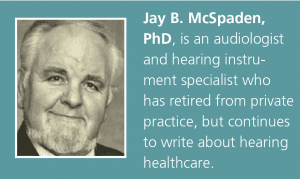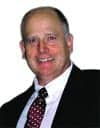Opinion | July 2017 Hearing Review
In the 60-year history of “modern” hearing aids, a consistent problem has been return-for-credit (RFC) rates, devices returned to the person who sold them or to the manufacturer for refund of all monies involved. The current RFC rate for industry (any returned unit, regardless of reason) is around 20%, although dispenser-reported RFCs are considerably lower (usually in the 5-10% range).
Attempts in the past to improve fitting techniques and satisfaction-building procedures around hearing instruments have ranged from auditory rehabilitation and loudness growth controls to live speech mapping. The manufacturer’s point of entry into this program has been to take the audiogram sent to them with the order form and have technicians at their factories translate the numbers on the audiogram, usually using NAL formulas that came from Australia 20 years ago, or the DSL, or other proprietary fitting formulas, etc. This permits the factory to send a device to the practitioner that is set on what is often referred to as “first-fit.”
The NAL formulas are quite good and accurate for approximately 90% of the patients. They are, however, 100% wrong for 10% of the patients. The concept of “first-fit” expresses a mentality analogous to presuming everyone is right handed—or that they ought to be. I’m old enough to remember that, as a child in grade school, all of us were required to learn to write with our right hand, whether we were right handed or not, because “that is the way everyone did it.” The First-fit tool is based on the same rationale, and it is no more accurate.
If our purpose is to really reduce the return rate of hearing instruments, we must observe a consistent process and make whatever changes are necessary in the performance of hearing aids to compensate for the difference between the “NAL” criteria and the actual audiometric and personal needs of the individual.
If we are careful about measuring the audiogram properly, and making the additional measurements that more fully represent the auditory capacity of the patient, we need to include, at bare minimum:
Threshold measurements,
- Threshold measurements,
- MCL measurements for speech,
- UCL measurements at frequency from 250 Hz through 6000 Hz, and
- Some baseline measurements for verification and validation to ensure benefit (satisfaction and value).
The threshold measurements represent the floor of the auditory behavior, and the UCL measurements represent its effective ceiling. It should be remembered that sound level sub-thresholds cannot be heard, and sound levels above UCL cannot be comfortably tolerated. This therefore represents the effective window, or dynamic range, into which auditory signals must be adjusted in order that they be comfortable and audible. This is the glass half-full approach to hearing aid fitting; it represents the patient’s residual hearing and the doorway that we can squeeze amplified sound into given the restrictions of what we call “recruitment.”
We have always done air-conducted threshold measurements and bone-conducted threshold measurements. And, to the extent that they yield identical results, the hearing represented is referred to as sensorineural hearing loss. Even though we have made these kinds of measurements and we have known for decades that we needed to do MCL and UCL measurements at frequencies, few transmit the data to the manufacturer. This is a source of a large percentage of the dissatisfaction that occurs with hearing aids because they are either too loud or not loud enough. In addition, by adding this additional data (MCL and UCL at frequency) we are better able to hone in on the presentation of sound at frequency that is loud enough to be heard clearly and within the tolerable range.
Additionally, there are several reasons for us to be more careful, more precise, and more comprehensive in our measurements:
- The demand for hearing aids is increasing as a function of the aging population in this country (and world).
- The performance of these hearing aids is now largely digital and represents a kind and quality of circuitry that—if testing, measurements, and the resulting programming are done properly—has the potential to transmit to the auditory system a more accurate and complete signal than ever before.
- The overwhelming need for this kind of device—as well as the need for quality, skilled hearing help—will ultimately lead seniors in this country to demand of their legislative bodies some financial assistance in defraying the cost of hearing devices.
- Should the government provide financial assistance in the acquisition of hearing aids, it will almost certainly require the dispenser and manufacturer of those devices to demonstrate that:
a) The fitting was properly performed; b) The outcomes were documented; c) The patient’s benefit and satisfaction with the hearing aids and associated rehabilitative services were measurable and commensurate with expectations relative to his/her hearing disability.
Failing to do that by either the dispenser, business owner, or the manufacturer would negate the validity of the sale. Anything other than this requirement is requesting a blank check on the treasury—and no legislative body would (or should) tolerate it.
The easiest way for hearing aids to be prescribed and fit includes the following:
- An accurate and thorough history of auditory behavior, problems, and the unique needs of the patient.
- An accurate audiogram, including thresholds and MCL and UCL at frequency from 250-6000 Hz.
- Based on these numerical values with NAL formulas applied to them, a device is eventually programmed to the “best fit,” which is only occasionally the “first fit.”
Normal speech testing and SRT measures also need to be performed in the unaided and aided conditions. Note that, when the patient’s spouse, friend, or family member reads these words and scores the performance, both the patient and that very important third party can instantly realize the improvement provided by the hearing aid.
When the device is fitted, it is also incumbent upon the clinician to perform “live speech mapping” or real-ear measurements (REM) in order to know the performance of the instrument as it compensates for the person’s compromised auditory function. When “live speech mapping” is done, a copy of the live speech mapping results are printed out and added to the patient’s chart. Any adjustments that need to be made can be seen “by inspection” and a permanent record of hearing aid performance is obtained. The same applies for REM. Either one should accompany every fitting in every chart.
Speech-in-noise testing is also an imperative in the modern hearing care practice. It is now well established that the audiogram and sensitivity to pure-tone signals are not predictive of a patient’s ability to understand speech in background noise. When the number-one persistent complaint of people who use hearing aids is lack of utility in noisy environments, then it’s the duty of hearing care professionals to measure pre- and post-fitting listening success in noise. There are many methods you can use (QuickSIN, HINT, SPIN, or your own) to assess hearing in noise. In my opinion, it doesn’t matter which one(s) you use; what matters is that you can demonstrate benefit for your clients.
The bottom line is that benefit with a hearing instrument can and should be measured, assessed, adjusted, and documented to achieve maximum performance capabilities for all patients.
Using these (and other) procedures allow us to have a complete and accurate record of the first fit, best fit, live speech mapping or REM, hearing instrument adjustment, and the performance of each individual aid across the entire frequency spectrum. It also permits us (or any other clinician or entity) to have a pictorial representation of the improvement in the patient’s performance, beginning with the unaided condition and proceeding through the aided performance, and including noisy environments.
The bottom line is that benefit with a hearing instrument can and should be measured, assessed, adjusted, and documented to achieve maximum performance capabilities for all patients.
Best Practices, Evolving Knowledge, and the Future of Dispensing
Due to space restrictions, it’s impossible to list every desired test and protocol (eg, validation) involved in a hearing aid fitting. Thankfully, the professional societies to which most of us belong—notably AAA, ASHA, ADA, and IHS—have published best practice guidelines that are outcome-based. That is, these are sets of guidelines and procedures (testing and services provided by you and your skilled staff) that are positively correlated with patient benefit and satisfaction with hearing aids (devices anyone can buy). These guidelines have evolved substantially over the years and my guess is that they will soon include recommendations for many other factors, such as cognitive testing, etc.
In the last 15 years, there have been several ideas put forward that would reduce the content of thorough auditory testing and largely trivialize hearing aid adjustment. The most recent approach to this problem is the suggestion that the FDA remove Class I and Class II medical device requirements in mild and moderate gain instruments, specifically for the establishment of a new “OTC hearing device” category—effectively relegating hearing aids to the severe-to-profound loss category.
The idea that only moderate-to-profound hearing loss requires professional help demeans the patient, presupposes an acceptable level of hearing impairment that I find professionally and scientifically objectionable, and diminishes the capacity of consumers to make adequate, evidence-based healthcare decisions.
I would submit that this concept diminishes the gravity of hearing loss in general and trivializes the decrease from mild through moderate impairment. The fact is that research suggests there is no such thing as a “mild” or “insignificant” hearing loss if someone is laboring to understand speech. This is particularly evident from the work being done on brain plasticity and cortical reorganization in response to “mild” hearing losses. I have worked in medical environments and hospitals for the past 45 years, and I cannot tell you the number of times that I have heard a doctor or nurse tell a patient, “We wish you had come in earlier but you have let it go too far.” The idea that only moderate-to-profound hearing loss requires professional help demeans the patient, presupposes an acceptable level of hearing impairment that I find professionally and scientifically objectionable, and diminishes the capacity of consumers to make adequate, evidence-based healthcare decisions.
In the future, it is going to require the cooperation and attention of all three entities in the hearing care field to ensure the survival of professionally-driven hearing healthcare and facilitate its progress. Its long-term future does require a significant reduction on the wholesale price of hearing aids (eg, the product), better accessibility and convenience (eg, telehealth), and improved adherence to best practices (eg, verification and validation) on the part of the professional. The final key to success is education about the use and benefit of hearing aids by consumers.
Perhaps the first step in facilitating the successful triumvirate—consumer, professional, industry—is to understand that the successful acquisition, use, and facility of hearing instruments requires an understanding that this is not a journey well suited to a “self-teaching exercise”; it’s not about “trying stuff and seeing if it works.” It’s about healthcare. When a cooperative patient (willing to ascend the learning curve) is combined with a skilled and qualified professional under the direction of a practice/business owner who insists on adherence to best practices and documented outcomes, the success of the venture—while taking slightly longer to perform—inevitably reduces “return rates” across the entire industry while increasing benefit, satisfaction, and the perceived value for the patient—and our entire profession (regardless of the group to which you belong).
Best practices combined with a significant reduction in the cost of hearing instruments, will of necessity, expand the utility of hearing healthcare. Without question, best practices guarantee a continued long and successful history for our field.

Original citation for this article: McSpaden JB. Cooperative prevention of an industry’s decline: heeding best practices. Hearing Review. 2017;24(7):42-43.





